Edna Walling and Australian Gardens
There is, currently in Australia, a great revival of interest in the work of Edna Walling (1896-1973). Walling lived an unusual life for a woman of her era, rejecting the traditionally feminine and working as designer, builder, gardener and groundswoman for a whole planned village (Bickleigh Vale Village) in her lifetime. Reprints of her books are now available, and Floriligeum publisher has recently reprinted a second edition of Peter Watts' book on her work, Edna Walling and Her Gardens (2002).
Trisha Dixon (Garden Design and Style, 1991) points out that "both Gertrude Jekyll's and Vita Sackville-West's gardening practices were a romanticized concept of the traditional practical cottage garden, which was literally a means of survival for the rural poor...The influence of these great garden writers has been far-reaching. Their basic ideals have been implemented in all corners of the globe with the addition of indigenous plants lending individuality "( p. 17). She goes on to note that "the well known garden designer Edna Walling did much to popularise the romantic garden in Australia and New Zealand. Following in the tradition of Gertrude Jekyll, she skillfully wove a tapestry of romance through her garden designs and writings, and was one of the first to appreciate the subtle beauty of the Australian flora" (p. 22).
Walling's designs fall mostly into three categories: informal cottage, structured, and formal geometric. Like Jekyll, Walling loved the informality and casualness of the cottage garden, where "the picture develops by 'slip' and cutting, by root and seed, brought in a neighbour's basket and poked into some quickly stirred up patch of soil which happens to be unoccupied" (Walling, Cottage and Garden in Australia, 1947, in Watts, 2002, p. 79). The plants supplied by Walling's nursery at her own cottage (Sonning) in Bickleigh Vale Village included many traditional English cottage favourites such as foxgloves, cynoglossums, columbines, sweet williams, and forget-me-nots. Like Jekyll, however, Walling favoured the underlying structure of low stone walls (often building these with her own hands), pergolas, and small pools as a foundation for flower colour. Trees were planted in copses, and shrubs were underplanted with bulbs so that, as Watts notes, "altogether the cottages took on the appearance of many of the snug cottages in the southwest of England" (p. 80). Walling's structured gardens were used in association with slightly larger houses on larger sections of about 1/4 to 1/2 acre, and her plans for these look very much like a Jekyll plan, with their garden rooms separated by hedges or low stone walls, abundantly planted with a profusion of plants, and her use of false perspective to make these small lots seem larger than they were. The third category, of formal geometric gardens, was used by Walling for very grand houses on large allotments. In the post-Depression era of the late 1930's cheap labour availability made these possible in and around Melbourne. As Watts describes them, "these gardens are characteristically geometric in design, sometimes rigidly so. Major formal elemants such as swimming pools, pergolas, decorative pools, tennis courts, terrace walls and colonnades are beautifully tied together by axial paths that intersect at critical locations in the design...these gardens gave Walling the opportunity to indulge her love of rockwork and architectural gardens on a grand scale" (p. 83).
I had the opportunity to visit a garden near Melbourne, Australia, that retains a small portion of a Walling design. Beleura was a private estate, but it is now a business funded by the trust fund left by the last owner, and is viewable by appointment. It is a good example of Walling's 'structured' design, although much of her original design has been altered by later owners. The part that is still 'pure Walling' is a section of stone pathway, bordered by low stone walls and planted luxuriously,but fairly 'green-ly'. This area has a rather Italianate feel to it, actually.
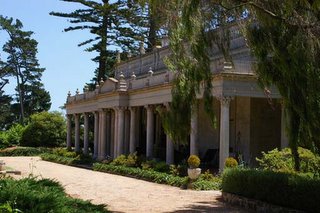
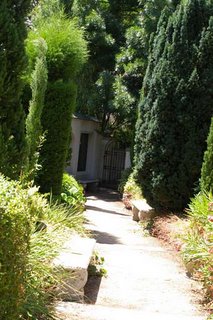
The rest of the garden is, in the English fashion, divided into various rooms with diverse themes, from an Oriental pagoda garden planted with bamboo, including a koi pond, to a children's garden with a Hansel & Gretel motif. All the usual English estate garden features are here: a potager garden, a summerhouse with lily pools, a stone terrace with climber-covered arbour, clipped hedges, perennial borders etc. The Australian difference is in the brilliant colours and exotic shapes of the planting, including hot pink bougainvillea, kangaroo paw, and the somewhat ubiquitous (if lovely) agapanthus in sweeps in a bulb meadow. The garden is lovely, if a bit eccentric. I believe, from studying her remaining planting plans for other gardens, that Walling would have preferred something a bit simpler and with fewer diverse theme areas, but the commercial aspect of this property has no doubt affected the current choices.


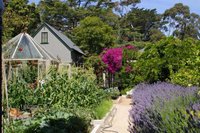
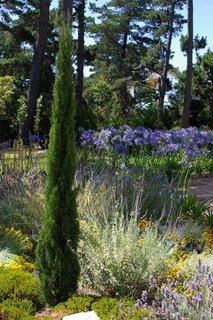
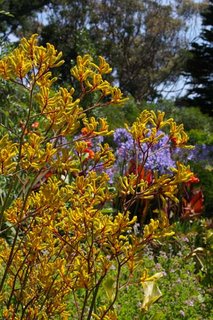
Walling was ahead of her time in promoting the use of Australian natives in public planting, however, and was quite famous for pestering public authorities about their planting choices on Australia's roadsides. In fact, in 1952 she wrote an entire book on the subject, entitled The Australian Roadside, in which she made a plea for the sole use of indigenous plants on the Australian roadsides, in order to "maintain and reinforce the regional character of a particular area" (Watts, 2002, p. 116). In an ecological approach, at a time long before that was common, Walling wrote that there is "a clear distinction between beautification or superficial decoration and fundamental organic roadside improvement" (in Watts, 2002, p. 116). As well, Walling went through a phase in her career in the 1950's when she insisted on only native plants being used in her garden designs (though later she relented and re-introduced suitable exotic species). Her interest dated back to the 1920's, when she collected and propagated many native plants at her home nursery at Sonning.
As Watts points out, "the source of the current Australian enthusiasm for native plants is complex and must certainly be linked with sentiments of nationalsim. But the work of people like Edna Walling, who promoted the concept of ecological planting and fostered an awareness among the public of the beauty of native plants, also played an important part" (2002, p. 118).
I enjoyed my exploration into this unique character in Australian horticulture. Her influence continues with a new generation of Australians, affected through her writings by her "deep love of the bush, her delight in its flowers, its complex ecology and its subtle beauty" (Watts, 2002, p. 121). I certainly heard echoes of contemporary Canadian writers such as Lorraine Johnson, who advocate the use of native plants and an ecologically sound approach to both public and private plantings.

0 Comments:
Post a Comment
<< Home